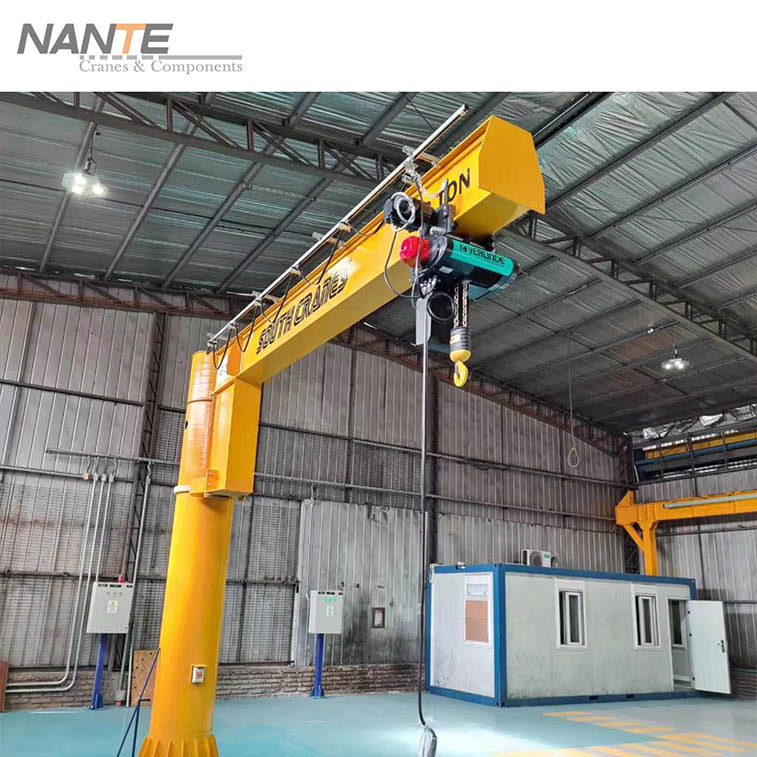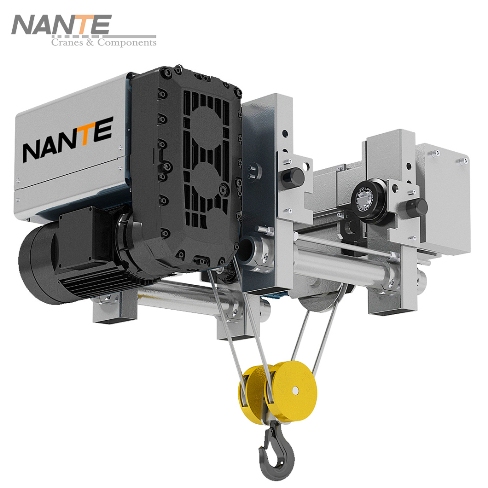What Is a Jib Crane?
Date: 2024-02-05 Share:
What Is a Jib Crane
A Jib crane is a kind of jib type crane in the fetching device that is rotated on the end of the arm or rotated on the lifting trolley that can be operated along the jib, and the jib can be rotated, but cannot be tilted. The following are some of the main features and uses of jib cranes:

Structural features: jib cranes are mainly composed of columns, slewing jibs, slewing drives and electric hoists. The lower end of the column is fixed on the concrete foundation through the foot bolt, and the swing arm slewing is driven by the cycloid reduction device. The electric hoist runs in a straight line left and right on the jib I-beam and lifts heavy objects. Jib crane jib is a hollow steel structure, light weight, large span, large lifting capacity, economical and durable.
Wide range of uses: jib cranes are a new generation of light lifting equipment manufactured to adapt to modern production. It is widely used in various industries in different places, especially suitable for short distances, frequent use and intensive lifting operations. In the section distance, intensive transportation occasions, more than other conventional lifting equipment to show its superiority.
Flexible operation: jib cranes operate flexibly to meet the loading and unloading requirements. Its high mechanical efficiency, equipment, operation and maintenance are convenient, and low cost. Jib cranes have three forms: fixed, mobile and floating. Fixed jib cranes are installed directly on the pier base of the wharf or yard, and can only be operated in situ. Mobile jib cranes are flexible and adaptable and are the necessary independent emergency lifting equipment for highly efficient automated production lines, which can ensure the smooth flow of the production line.
Economical and practical: jib cranes are relatively economical heavy-duty material handling solutions, that can be used to lift larger loads to meet the requirements of higher productivity. It has a lifting capacity of up to 5 tons and a span of up to 7 meters. Built-in walking mechanism using special engineering plastic walking wheels with rolling bearings, low friction, walking light; and small structural dimensions, especially conducive to improving the hook stroke.
Jib cranes are a kind of lifting equipment characterized by high efficiency, energy saving, time-saving, labor-saving and flexibility, which are widely used in different places of various industries.
Jib Crane Components
Jib Crane is a practical light-duty lifting equipment, mainly composed of the following components:
Column: The column is the supporting part of the jib crane, which carries all the weight of the jib and the hoisted items. The manufacturing accuracy of the column will directly affect the working performance of the crane.
Rotating arm: the rotating arm is welded by the combination of I-beam and support, one end of which is connected to the column, and the other end is equipped with an electric hoist. The rotating arm can rotate around the column, thus realizing the movement of lifting items in the horizontal plane.
Electric hoist: An electric hoist is an important lifting mechanism of the jib crane, which is responsible for the lifting and lowering movement of the hoisted items. The performance and quality of the electric hoist will directly affect the lifting capacity and efficiency of the crane.
Electric chain hoist: An electric chain hoist is a kind of light lifting machinery, it has a compact structure, lightweight, small in size, easy to operate and so on. The application of an electric chain hoist in a jib crane makes the crane have higher working efficiency and a larger lifting range.
Traveling mechanism: the traveling mechanism of jib cranes is generally driven by electric motors, through the gear drive or chain drive to realize the crane’s travel. The design of the traveling mechanism should ensure that the crane is stable and smooth in the process of traveling and has enough driving force and braking force.
Electrical part: the electrical part includes the motor, electrical control box, push button switch, cable reel and so on. The electrical part is the control center of the jib crane, which is responsible for controlling the actions of the crane to ensure safe and reliable operation of the crane.
In addition, the jib crane may also include some auxiliary parts, such as support arms, reducers, brakes, limiters, etc. These parts also play an important role in the operation of the crane.

Examples of Jib Cranes in Action
Jib cranes have a wide range of application scenarios, due to their structural features and functional characteristics, they are often used in a variety of occasions that require efficient and flexible material handling. The following are some specific application scenarios:
Construction field: jib cranes are widely used in high-rise building construction, which can conveniently transport heavy materials, equipment, tools and other items to the construction site to improve construction efficiency. During the construction of railroads and highways, jib cranes can also lift heavy bridge components for easy installation and assembly.
Power Infrastructure: In the process of installation and maintenance management of power infrastructure for urban development, jib cranes can lift items such as transformers, wires and cables of higher weights to facilitate the work of construction technicians for system installation and maintenance services.
Urban road construction: jib cranes can also be used in urban road construction, lifting street lights, signal lights and other facilities, making installation and maintenance more convenient.
Machinery manufacturing and maintenance: jib cranes also play an important role in the manufacturing and maintenance of mechanical products, especially in short distances and frequently used places such as workshops and warehouses. It can easily lift a variety of parts and tools to improve productivity.
Other industries: In addition to the above areas, jib cranes are also widely used in railroads, chemical industries, and light and small industries, such as production production and maintenance processes.
In short, jib cranes are widely used in various fields because of their high efficiency, flexibility, economy and other characteristics. When choosing jib cranes, you need to make reasonable configuration and selection according to the actual demand and working environment.
 English
English






